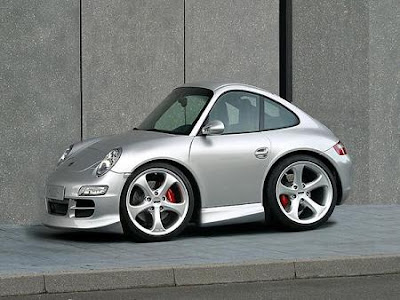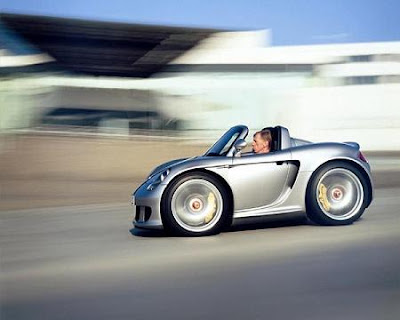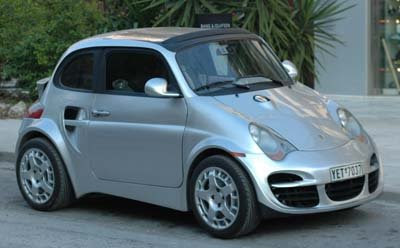Introduction
Back when the first generation CTS was still in production, the folks at Cadillac had a bright idea: shoehorn a Corvette engine in the CTS, slap on a series of go-fast goodies and give the traditional kings of super-sedan Hill -- - - BMW M5, Mercedes-Benz AMG's various sports sedan and Audi's S6 - something to worry about. Cadillac called it the CTS-V, and its performance numbers were indeed impressive, as was its relative affordability. In other ways, but it was not quite ready for prime time, from its low-buck interior to its stated rear axle-hop during acceleration runs.

This year it is a whole new ballgame. 2009 Cadillac CTS-V, based on far superior second-generation CTS platform, ditches the axle hop, is a first-rate interior and? Perhaps most importantly? achieves record-breaking four-door speed. The 556-horsepower, Supercharged 6.2-liter V8 (which is essentially a slightly detuned version of the same engine found in the Corvette ZR-1) helps the new V made some ridiculous straight-line times: zero to 60 km / h in 4.3 seconds and the quarter-mile in 12.4 seconds at almost 115 km / h. In addition, the CTS-V is equally impressive when the going get twisty. In a recent comparison test, we found out for ourselves what Cadillac had told us all along - V is faster than both the M5 and C63 AMG around a racetrack, despite a base price that is nearly $ 25,000 less than BMW.
Stupendous performance rights aside, there are a few drawbacks worth mentioning. First and foremost, it's hard to tell from the driver's seat, there is a V8 under the hood. The compressor whine is omnipresent, and it is expected V8 rumble is AWOL. Second, the automatic transmission can feel raw at times, thanks to a slow-witted manual mode, upshifts and rough in both Sports Drive and manual modes. Moreover, the standard seats are not very different from those in the regular CTS, which is disappointing in a dedicated sports machine? although the optional sports seats RECARO is irreproachable.
The super-sedan segment is an embarrassment of riches these days, with many German players boast sophisticated design, sports-carlike handling and sonorous V8 or V10 engines. But the 2009 Cadillac CTS-V has elbowed its way to the leader of this sparsely occupied class with its unparalleled all-around performance, stylish metal plates and reasonable prices. We are particularly pleased with the smaller M3 and C63 AMG sports sedan, which competes directly with Cadillac at the price, but the dimensions of the CTS-V put it together more, much more expensive competitors. Super-sedan customers owe itself to take a hard look at this hard core Caddy.
Body style, trim levels, and Options
2009 Cadillac CTS-V is a high-performance sports sedan that comes in a single trim level. Standard features include 19-inch alloy wheels, Brembo brakes, adaptive xenon headlamps, an adaptive suspension with driver-adjustable shock absorbers, keyless entry and ignition (including remote start the automatic transmission models), rear park assist, leather upholstery, a leather - wrapped power tilt -telescoping steering wheel cylinders, power-adjustable heated front seats with driver memory, dual-zone automatic climate control, OnStar and Bluetooth. Also standard is a 10-speaker Bose surround-sound audio system with a CD/MP3 player, satellite radio, a USB port, an iPod-ready auxiliary audio jack and a 40-gigabyte hard drive that can be used to store music .
Options include a hard-drive-based navigation system with real-time traffic and weather reporting, 14-way power-adjustable RECARO sports seats with heating and ventilation, a suede-trimmed steering wheel and a sunroof.
Power Trains and Performance
A Supercharged 6.2-liter V8 powers the 2009
Cadillac CTS-V, send a whopping 556 horsepower and 551 pound-feet of torque to the rear wheels. A six-speed manual transmission is standard, and a six-speed automatic transmission with steering wheel-mounted shift buttons is optional. For performance testing, automatic-equipped CTS-V catapulted to 60 km / h in 4.3 seconds and flew through the quarter-mile in 12.4 seconds at 114.7 mph. Brake Capacity was also phenomenal, as our test car stopped from 60 mph in a seatbelt-strain 104 feet. Cadillac estimates that the CTS-V will return 13 mpg in the city and 19 mpg on the highway.
Security
2009 Cadillac CTS-V comes standard with anti-lock brakes, traction control, stability control, front-seat side airbags, full-length side curtain airbags and GM's OnStar emergency communications system.
The Insurance Institute for Highway Safety crash tests, the regular CTS earned scores of "Good" (the highest possible) for both frontal-offset and side-impact protection. In government crash tests, the CTS earned four out of five stars for driver protection in head-on collisions, while the front passenger received five-star protection. The CTS also received five stars for side-impact protection for front and rear passengers.
Interior design and special features
2009 CTS-V's interior is not very different from the regular CTS. Fortunately, the building boasts one of the nicer interior in its segment, with a sleekly attractive center stack design and mostly high-quality materials. We would advise skipping the base seats, as they are neither supports nor particularly comfortable. Get the optional RECARO sports seats instead, who has a crush on all the right places, but comfy enough for long trips. Rear seat dimensions are satisfactory, even for larger adults. The regular CTS's available split-folding rear seat is not available on the CTS-V, although a pass-through is standard. Bagage offers 13.6 Cubic holds, although reading the major issues is hampered by a short deck.
The design of the optional navigation system is particularly clever, display withdrawn in line, but the top inch of the screen remains visible for the audio system. Another well thought out feature is standard 40 GB hard drive, which not only allows for storage of music files, but enables AM / FM and satellite radio to be rewound, paused and resumed? much like a DVR for radio. Bose surround-sound audio system provides rich bass and a pleasingly warm sound.
Driving Impressions
At 4313 pounds, the 2009 Cadillac CTS-V weighs as much as some crossover SUVs. This makes his face flattening performance even more amazing. Despite the otherworldly lap times, although the CTS-V ultimately can not hide his 2-ton-plus mass on winding roads. The CTS-V feel a little portly in tight corners, although the 556 horses make amends in a hurry when the road straightens out. The default setting steering mechanism is too light for a high-performance sports sedan, but it is easily remedied by tapping the traction control button twice - this activates Competitive driving, weighing up to the steering, traction control turned off and switch to a more lenient stability control program for aggressive driving.
The automatic transmission's lurching full throttle upshifts are crude, but effective, although we can not say the same to the manual shift buttons on the back of the steering wheel spokes. They are so slow on the draw, you're better off just leaving the transmission in Drive Sport. The manual transmission can be a better bet, since it has a positive corporate change efforts and a surprisingly light and progressive clutch.



































































